This triangular-shaped town on Lewis County’s northwest boundary contains the traffic corridors into Jefferson County and the great St. Lawrence River Valley. It is here that the Black River, after idling past the shores of Denmark for a greater distance than in any other Lewis County town, enters Jefferson County where it soon turns west to join the waters of Lake Ontario. Reaching an elevation of 1500 feet on its western limits at a point on the Hayes Road commonly known as Champion Peak, the town of Denmark rises the least in height of any of those townships lying west of the Black River. The 1961 assessment roll shows it containing 31,025 acres of land. There are only 47 acres under state reforestation, of which 32 are plantation acres.
The population of Denmark in 1820 was 1,745, in 1880 it was 2,204 and in 2010 it was 2,860.
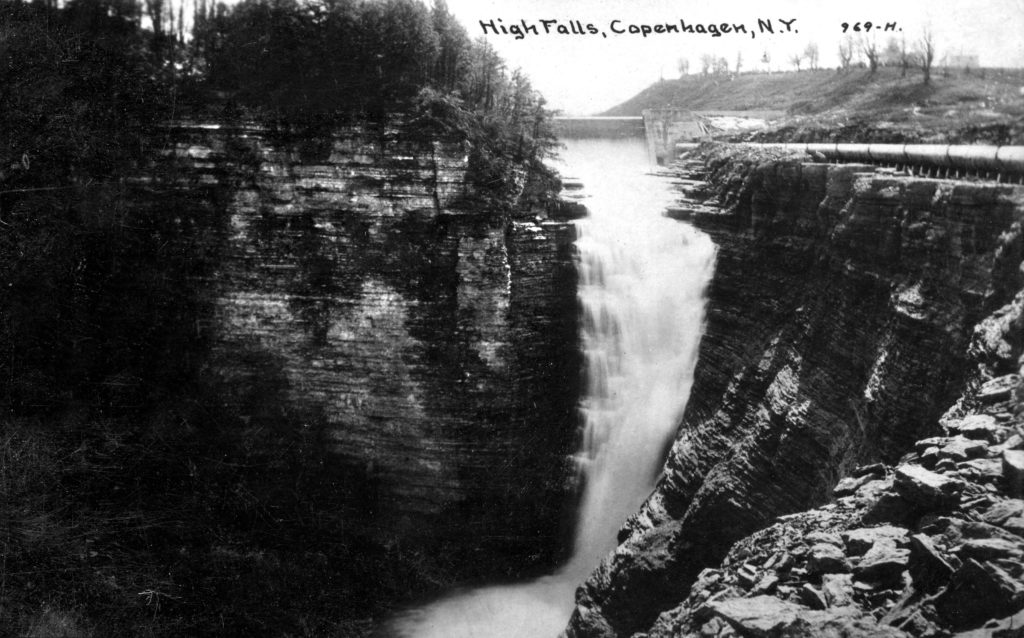
Deer River, a large and unpredictable stream known to the early settlers as “Deer Creek,” during the 19th century and for a few years after, turned waterwheels for a variety of industries as it made the plunging descent northeasterly through the center of town to join the Black River. There, mingling with the waters from 16 other Lewis County towns, it continues its journey to the sea. It served as a public way in the transportation of pulpwood by log drives during the spring floods prior to 1900 and for a short time thereafter. This stream in its annual flood rampage, swollen by the melting snows in the wilds of Montague, has been the scene of many interesting incidents, both tragic and destructive. Notwithstanding its seasonal brutal savageness, Deer River with its many small tributaries has been an important factor in the creation of some of the best watered dairy farms in the county.
Containing little forest land, the beautiful grove-dotted landscape reflects the farsightedness of its axe-swinging settlers, who visualized the needs of generations to follow, when they so wisely withheld the destruction of selected stands of sugar maple while in the process of clearing the land for agricultural use.
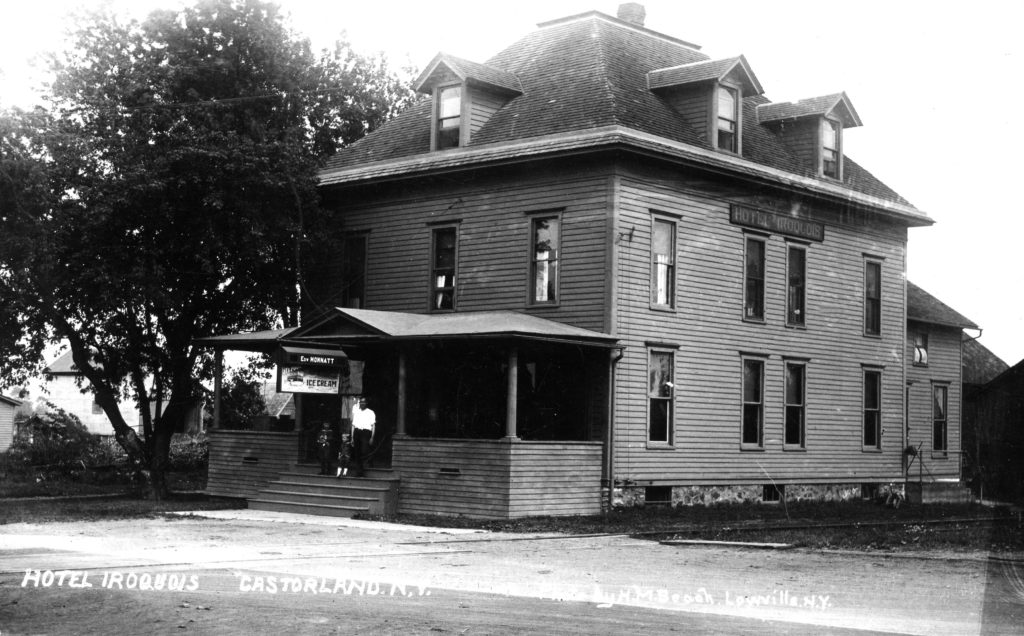
There are two beautiful waterfalls within the town created by the waters of Deer River as it tumbles over the limestone ledges. High Falls, the more spectacular, being nearly the height of Niagara Falls (170 feet), is located at the eastern border of the village of Copenhagen and presents an awesome site when the river is in flood. Kings Falls, so named because of ex-King Joseph Bonaparte’s affection for the beautiful setting of the 40-foot cascade, is located downstream about 2 miles below High Falls.
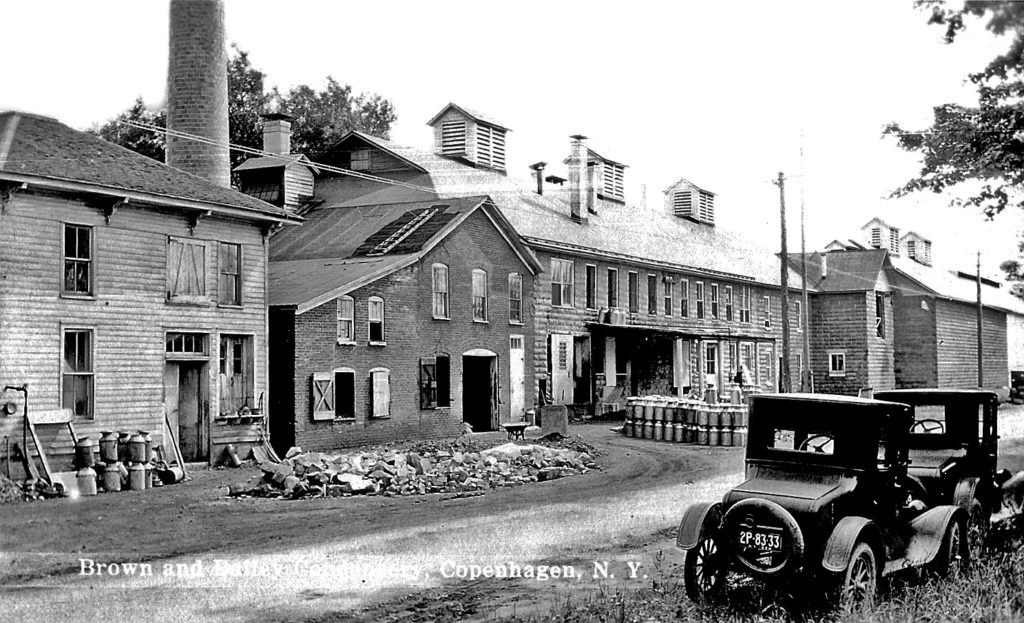
Cook Bros. of Denmark operated the union cheese factory on their farm for a number of years and in 1893 augmented the use of milk at this plant by the installation of a separator, which opened a new market for the sale of cream. This venture proved successful and was continued for several years. The old Cook Bros. two-story stone factory burned in March 1906. In April of that same year, a farmers organization was formed and a new and much larger plant was erected nearly opposite the Freedom Wright Tavern. The new plant was known as the Crown Brand Cheese Factory. Milk was brought to this plant from as far away as Harrisburg and Copenhagen. Cream was shipped in large quantities to Baumert’s plant in Antwerp and to New York City. By 1895, Cook and Otis had established cheese manufactories at Copenhagen and Clark’s Corners, which they operated until 1904, when they sold their interests.
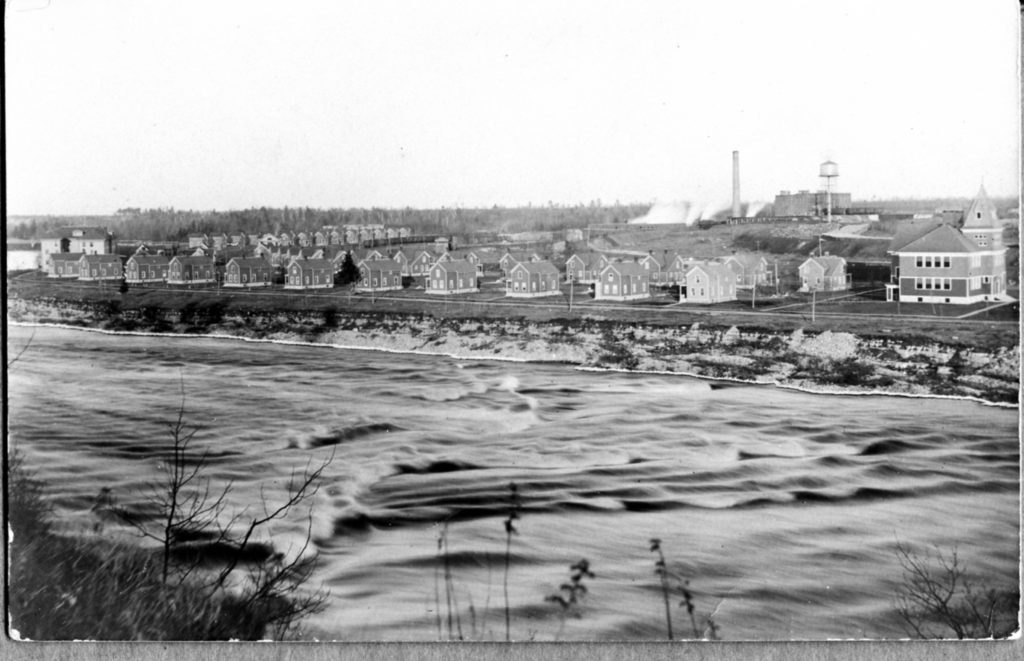
The name Mungers Mills had been adopted by early settlers from the community that grew up around the Deer River power site where Nathan Munger and his son, millwrights by trade, had erected the first gristmill in 1800, followed by a sawmill the following year. In 1807 the inhabitants of Mungers Mills, to indicate their resentment against the British and sympathy for the citizens of the defenseless city of Copenhagen, Denmark, then under siege by the British, elected to change the name of their bustling little community to Copenhagen. This seemed most appropriate as this new Copenhagen was also located in a new Denmark. Copenhagen was incorporated on February 22, 1869, at which time the population within the 751 acre bounds was given as 559. Succeeding census figures are as follows: in 1880, 702; in 1960, 673; and in 2010, 801.
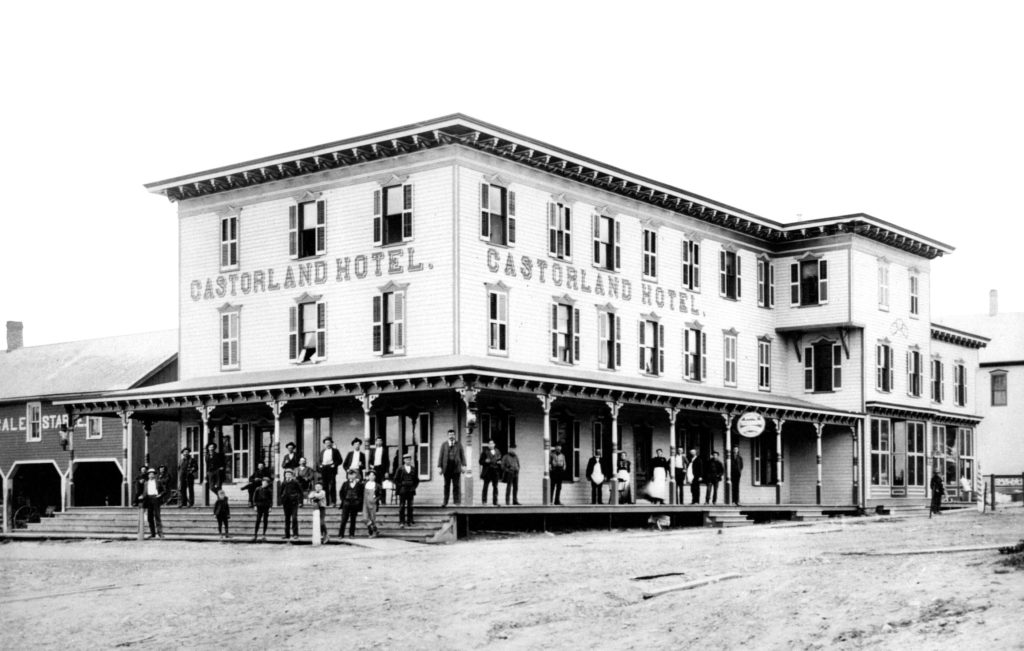
A serious fire occurred in this community on November 2, 1889. The blaze which started in Corcoran’s wagon shop located on the west side of Main Street, next to the bridge, destroyed the entire block. The following buildings were also lost: W.O. Munger Meat Market, Myrtle Corcoran’s house; the residence of Fred A. Greene; the W.S. Stiles block with Dr. Tamblin’s office; Mrs. A. Boynton’s house; Thomas Battle’s meat market; the E.J. Noyse block; Lyman Mitchell residence; and James Mitchell block.
The village had scarcely recovered from the fire and set itself to the task of rebuilding when on September 12, 1890, the worst recorded flood on Deer River came roaring down from the hills sweeping away all obstacles within reach of its raging torrent. Several buildings, waterwheels, bridges and dams were carried away. The mills of Twining and Keys, Plank and Nellis and Ward’s sawmill were among the more extensively damaged. Both Twining and Ward rebuilt the same fall. The Twining mill was still active in 1903. Plank and Nellis corrected a new veneer mill in 1891.

On April 18, 1966, this small village was honored by a visit from the Lord Mayor, Urban Hansen, of the city of Copenhagen, Denmark. This visit was a result of an open invitation contained in the letter of introduction written by Stanley Parsons, Mayor of Copenhagen, New York, for William Lacey was in Denmark in 1965 as part of a European tour after graduation from Oswego State University.
The second village in Denmark’s Township, Castorland, was named to commemorate the Castorland Colony of early days and the part played by those early French adventurers in establishing a settlement on their inland domain. Located on the west bank of the Black River, opposite the mouth of the Beaver River, Castorland served as the principal shipping center and nearest approach by rail for the busy industries that were attracted by the fine power potential of the lively Beaver River. The population in 1960 was 315.
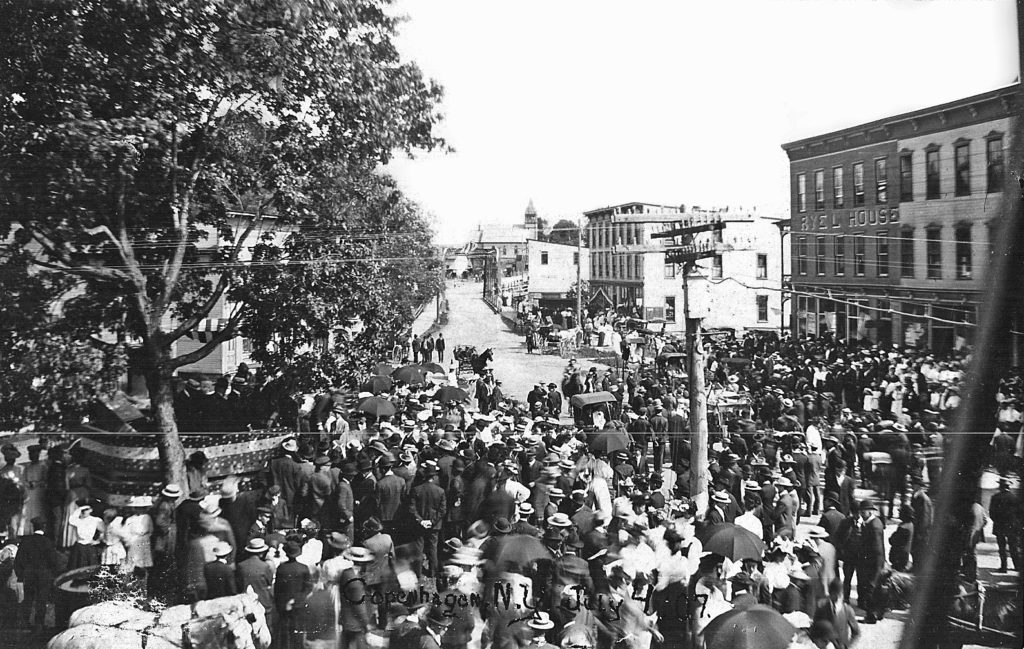
Little more than a crossroads railroad stop boasting a hotel and two or three houses prior to 1882, this village became one of the county’s busiest communities. It was here that T.B. Basselin erected a big sawmill in 1883 heralding his entrance into a logging and lumbering career that was to bring him fame and fortune.
In 1885, Andrew R. Shantz built a planing mill and box factory and in 1887 Timmerman Brother, erected a kindling wood factory, both adjacent to Basselin’s mill, from which came the materials for boxes and kindling wood. The number employed by these two industries was more than 400. A Journal and Republican item of March 1894 stated that 137 carloads of lumber and manufactured articles had been shipped from Castorland during the year.
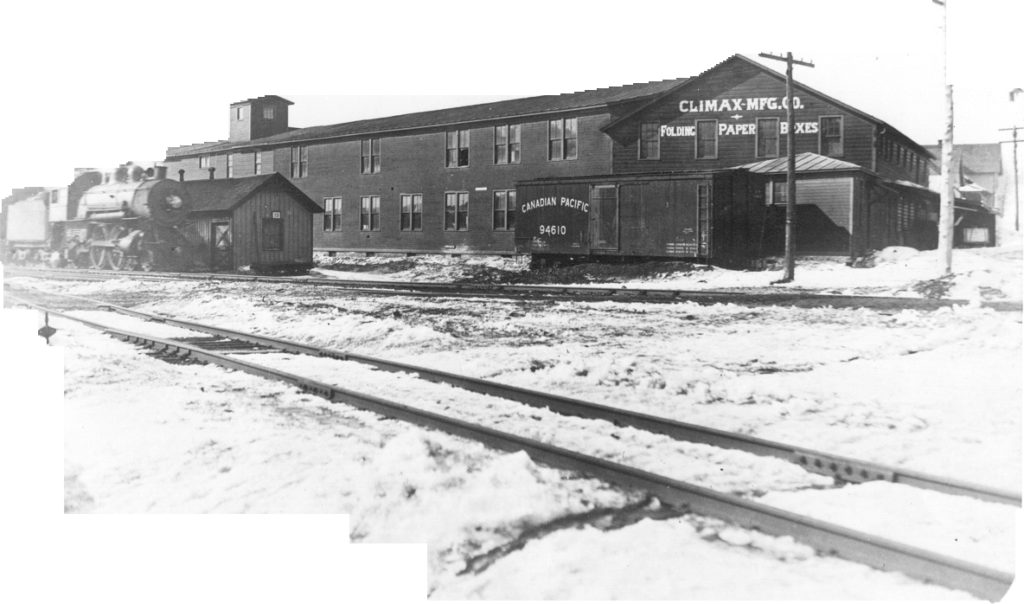
A progress report of 1897 states that in May of that year four stores, one hotel and six houses were under construction and the mills were running full force. Basselin’s mill ran day and night, two 12-hour shifts, each shift sawing out more than 100,000 feet of lumber.
